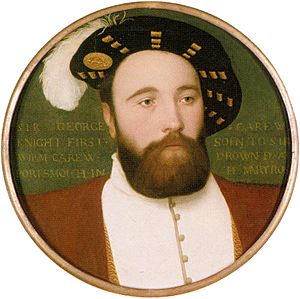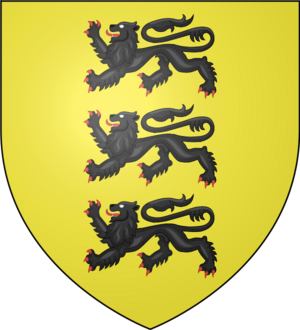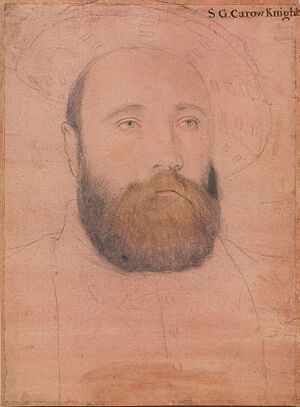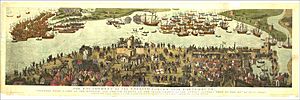George Carew (admiral) facts for kids
Quick facts for kids
Vice-Admiral Sir
George Carew
|
|
|---|---|

Sir George Carew (1504–1545)
(Circle of) Hans Holbein the Younger |
|
| Born | c. 1504 Preston, Devon |
| Died | 19 July 1545, aged c. 41 Portsmouth harbour, Battle of the Solent |
| Allegiance | |
| Service/ |
Army, Navy |
| Spouse(s) |
|
Sir George Carew (around 1504 – 19 July 1545) was an important English soldier and admiral during the time of King Henry VIII. He is best known for his tragic death when the famous English warship, the Mary Rose, sank. This happened during the Battle of the Solent in 1545, when France tried to invade England.
George Carew came from a well-known family. In his younger years, he was quite adventurous and sometimes got into trouble. However, he later became a trusted advisor and military leader for King Henry VIII.
Contents
Early Life and Education
George Carew was born around 1504 in Preston, Devon. His father was Sir William Carew, and his mother was Joan Courtenay.
George and his brother, Peter Carew, were sent to live and learn in the home of their mother's cousin, Henry Courtenay, 1st Marquess of Exeter. Here, they were influenced by adventurous relatives. These included their uncle, Gawen Carew, and another relative, Nicholas Carew.
George Carew studied law for a short time. However, he soon became bored with it. In 1526, he traveled to Blois, France. He hoped to find work serving the French Regent, Louise of Savoy. King Henry VIII later forgave him for this attempt to serve a foreign power. The King also encouraged him to behave responsibly.
Family Life and Marriages
George Carew was married twice, but he did not have any children.
- His first wife was Thomasine Pollard. She was the daughter of Sir Lewis Pollard, a judge. Thomasine sadly died suddenly in 1539 in Calais. This happened shortly after King Henry VIII's fourth queen, Anne of Cleves, arrived.
- His second wife was Mary Norris. They married in late 1540. Mary was the daughter of a courtier named Henry Norris. Mary had worked as a maid of honour for Queen Anne of Cleves. She also served Queen Catherine Howard, who gave Mary a necklace as a wedding gift.
Career in Public Service
Carew became interested in politics in the early 1530s. In 1529, he served as a Member of Parliament for Devon. He later became the High Sheriff of Devon in 1536 and 1542. During this time, he was also knighted by the King.
In 1537, Carew received his first job at sea. He served in the English Channel under Sir John Dudley. They worked to stop pirates. In 1538, he inherited his father's lands and returned to Devon. There, he served as a Justice of the Peace.
After his first wife died in 1539, Carew returned to the King's service. He took charge of the important fort of Rysbank near Calais. The fort was in poor condition, and Carew worked hard to repair it. He also helped manage Calais under its leader, Arthur Plantagenet, 1st Viscount Lisle.
During this period, Carew showed his support for Protestant groups. These groups had come to Calais to escape persecution in other parts of Europe. His strong stance on this issue earned him respect from many people.
In 1540, Carew was briefly questioned about a plan to give Rysbank to the French. He was not found to be involved in the plot. Later that year, he married Mary Norris. They settled at Polsloe Priory near Exeter.
Carew took his duties seriously. He was rewarded with a second term as sheriff in 1542. He was also made Steward of the Marquess of Exeter's properties, which came with a good salary. In 1544, he became a lieutenant of the Gentlemen Pensioners, earning an even larger salary.
Military Campaigns
In the summer of 1543, Carew wanted to join the army of Sir John Wallop in Flanders. He became a lieutenant general of horse. Even though Carew was a skilled jouster, he was new to military tactics. He learned a lot by serving on Wallop's army council.
George Carew and his brother Peter fought in battles outside the French towns of Thérouanne and Landrecies. At Landrecies, Carew faced danger twice. He was almost killed by a sniper's bullet. Later, he was captured after chasing French cavalry too far. However, King Henry VIII quickly asked for his release, and he returned to the English army.
In 1544, Carew gathered twenty soldiers to join Wallop's campaign against Boulogne. He also received a naval command under Dudley in the English Channel.
The Sinking of the Mary Rose
In July 1545, England expected a French invasion. Carew was called to King Henry VIII's war council aboard his flagship, the Great Harry, in Portsmouth. There, Carew was made Vice-Admiral of the fleet in Portsmouth. He received a golden whistle as a symbol of his new role.
The French fleet landed on the Isle of Wight that same day. Soon after, they sailed towards Portsmouth. The French force was much larger than the English fleet. It had 175 ships, including 25 large galleys. Carew was the captain of the Mary Rose, which was a very important ship in the English fleet. He sailed to meet the French, and that is when disaster struck.
No one knows exactly why the Mary Rose sank on 19 July 1545. It is believed that water rushed into its open gunports after it fired its cannons. The ship then sank in minutes. Some reports say Carew's last words were to his uncle, Gawen Carew, on another ship. He supposedly said, "I have the sort of knaves I cannot rule." This might mean there were problems with command or discipline on board. Carew had only taken command of the ship that very day, so his authority was new.
The Solent is a dangerous area for ships due to strong winds, tides, and shallow waters. Modern studies also suggest the old 700-ton warship was dangerously heavy. It carried heavy bronze cannons it was not designed for. Nearly 500 men were on board, many wearing heavy armor. Studies of the crew's skulls show that most of the men on the Mary Rose that day were likely from Southern Europe, possibly mercenaries.
King Henry VIII watched from Southsea Castle as the Mary Rose tilted over and sank. He heard the screams of the drowning crew. Most of them were trapped under a heavy net across the ship's upper deck. Lady Carew, who was with the King, fainted at the sight. Of the 500 men on board, fewer than 25 survived. Sir George Carew was not among them. His body was never found.
Despite the disaster, the French fleet did not fight effectively with the English. They turned away and carried out smaller raids elsewhere before returning to France in August. When the Mary Rose was brought up from the seabed almost 450 years later, pewter plates with "G.C." (Carew's initials) were found among the items from the wreck.
Carew's widow, Mary, later married Sir Arthur Champernowne in 1546. She continued to serve as a lady-in-waiting to the King's daughters, Mary and Elizabeth.
|





